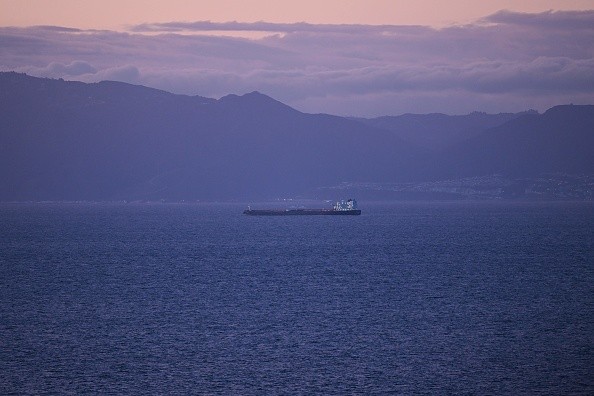According to one study, intense global warming could reduce the ocean's ability to absorb carbon dioxide, resulting in accelerated global warming as the greenhouse gas accumulates in the atmosphere.
The decline is caused by a surface layer of low-alkalinity water that forms during extreme warming, impeding the oceans' ability to absorb CO2.
The study is based on a climate simulation that was set up to simulate a worst-case emissions scenario, which the researchers say must be avoided at all costs.
Ocean surface tipping point could accelerate climate change
 (Photo : PATRICK T. FALLON/AFP via Getty Images)
(Photo : PATRICK T. FALLON/AFP via Getty Images)

By absorbing carbon dioxide emissions, the oceans help to limit global warming. However, scientists have discovered that future intense warming could reduce that ability, leading to even more severe warming, as per ScienceDaily.
The discovery comes from a study led by The University of Texas at Austin in which researchers examined a climate simulation configured to a worst-case emissions scenario and discovered that the oceans' ability to absorb carbon dioxide (CO2) would peak by 2100, becoming only half as efficient by 2300.
The decline is caused by the formation of a surface layer of low-alkalinity water, which reduces the ability of the oceans to absorb CO2. Alkalinity is a chemical property that influences the amount of CO2 that can dissolve in seawater.
Although the study's emissions scenario is unlikely due to global efforts to limit greenhouse gas emissions, the findings reveal a previously unknown tipping point that, if activated, would release a significant brake on global warming, according to the authors. The findings were published in Geophysical Research Letters. Today, the oceans absorb roughly one-third of all CO2 emissions produced by humans.
Previous climate simulations had shown that the oceans slow their CO2 absorption over time, but none had considered alkalinity as an explanation. To arrive at their conclusion, the researchers recalculated parts of a 450-year simulation until they identified alkalinity as a major cause of the slowing.
The effect, according to the findings, begins with extreme climate change, which increases rainfall and slows ocean currents. This covers the ocean's surface in a warm layer of fresh water that won't mix easily with the cooler, more alkaline waters beneath it.
As this surface layer becomes more CO2-saturated, its alkalinity decreases, as does its ability to absorb CO2.
The end result is a surface layer that acts as a CO2 absorption barrier. This means that less greenhouse gas enters the ocean and more remains in the atmosphere. This causes faster warming, which helps to maintain and strengthen the low-alkalinity surface layer.
The discovery, according to co-author Pedro DiNezio, an affiliate researcher at the University of Texas Institute for Geophysics and associate professor at the University of Colorado, is a powerful reminder that the world needs to reduce CO2 emissions to avoid crossing this and other tipping points.
The findings of the study, according to coauthor Nikki Lovenduski, a professor at the University of Colorado who contributed to the Intergovernmental Panel on Climate Change 2021 climate report, will help scientists make better projections about future climate change.
Also Read: Industrial Pollution: US Joins Ocean Panel to Work with World Leaders to Enforce Ocean Protection
How Is Climate Change Impacting The World's Ocean
As the excess heat and energy warm the ocean, the temperature change causes unprecedented cascading effects such as ice melting, sea-level rise, marine heat waves, and ocean acidification, as per UN.
These changes have a long-term impact on marine biodiversity and the lives and livelihoods of coastal communities and beyond, affecting approximately 680 million people who live in low-lying coastal areas, nearly 2 billion who live in half of the world's coastal megacities, nearly half of the world's population (3.3 billion) who rely on fish for protein, and nearly 60 million people who work in fisheries and the aquaculture sector globally.
Because of increased ice loss in the world's polar regions, sea-level rise has accelerated in recent decades.
According to the most recent World Meteorological Organization data, global mean sea-level reached a new high in 2021, rising an average of 4.5 millimeters per year from 2013 to 2021.
Sea-level rise has exacerbated extreme events such as deadly storm surges and coastal hazards such as flooding, erosion, and landslides, which are now expected to occur at least once a year in many locations. Historically, such events occurred once every century.
Marine heatwaves have doubled in frequency, becoming longer-lasting, more intense, and more widespread. According to the IPCC, human activity is the primary cause of the observed increase in ocean heat since the 1970s.
Between 2006 and 2015, the majority of heatwaves occurred, resulting in widespread coral bleaching and reef degradation. Nearly 60% of the world's ocean surface experienced at least one spell of marine heatwaves in 2021. According to the UN Environment Programme, if the water continues to warm, all of the world's coral reefs will bleach by the end of the century.
Coral bleaching occurs when reefs are stressed and lose their life-sustaining microscopic algae. The most recent global bleaching event began in 2014 and lasted until 2017, spreading across the Pacific, Indian, and Atlantic oceans.
Related article: Researchers Gather Thousand Marine Micro-organisms Samples to Understand Ocean Plankton and Pollution
© 2024 NatureWorldNews.com All rights reserved. Do not reproduce without permission.

![Tsunami Hazard Zones: New US Map Shows Places at Risk of Flooding and Tsunamis Amid Rising Sea Levels [NOAA]](https://1471793142.rsc.cdn77.org/data/thumbs/full/70325/280/157/50/40/tsunami-hazard-zones-new-us-map-shows-places-at-risk-of-flooding-and-tsunamis-amid-rising-sea-levels-noaa.jpg)



